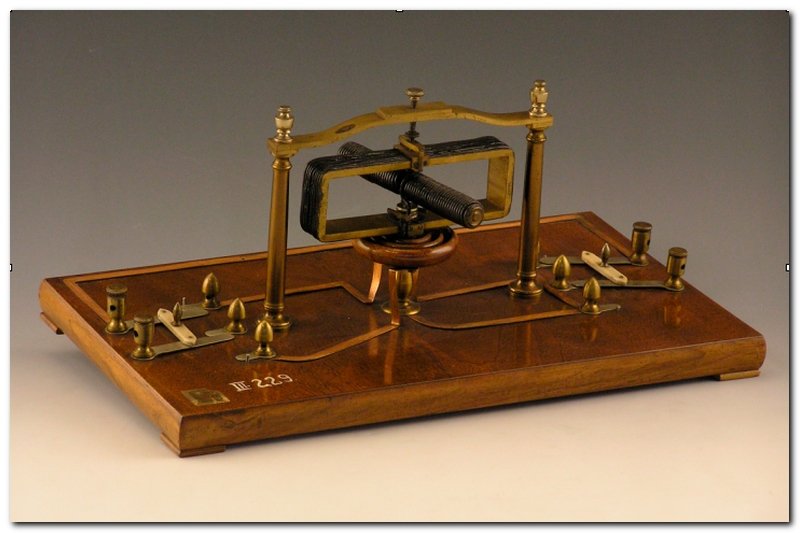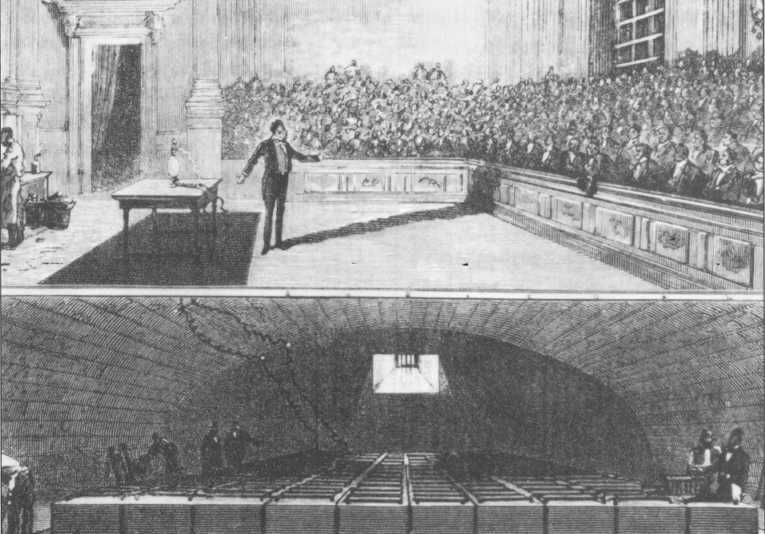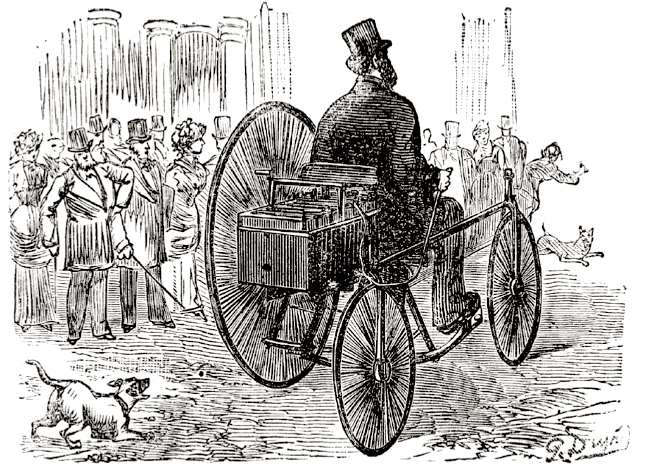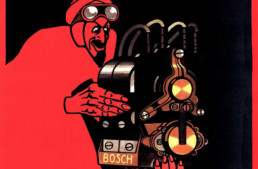The history of electric vehicles is little discussed today, but goes back well into the 19th Century, paralleling developments in steam power for vehicles, and predating the use of petroleum to power engines. We all know the story of Benjamin Franklin and his experiments with kites in storms in the 1700s, but compared to steam (the first experiments date back thousands of years), electricity is a relatively new field. In this series, The Vintagent explores the roots and development of electric powered two-wheelers, as part of our celebration of e-Bikes on our web channel The Current.]




“The slightly increased labour of climbing a hill is nothing to the zest imparted by a knowledge that there is sure to be a hill the other side to go down, and that is the most luxurious travelling that can be imagined. Descending an incline at full speed, balanced on a beautifully tempered steel spring that takes every jolt from the road – wheels spinning over the ground so lightly they scarce seem to touch it – the driver’s legs rested comfortably on the cross-bar in front – shooting the hill at a speed of thirty or forty miles an hour – the sensation is only comparable to that of flying.”
The idea of adding a motor to the bicycle was a natural follow-up, to perpetuate this amazing feeling: the exhilaration felt by all motorcyclists on an open road and a rising throttle. The idea for the electric motorcycle was first suggested (it seems) by the very fellow who first patented the concept of the motorcycle itself: Louis-Guillame Perreaux. There has long been a debate over who built the first motorcycle – Perreaux or Sylvester H. Roper (read our story about Roper here), but it seems today Roper built the earlier machine, while Perraux probably built his in 1870/’71, and patented his steam-cycle in 1871 (Roper never patented his motorcycle, but did ride it extensively). Of course, a credible claim can be made that the motorcycle concept dates back to 1818, as discussed in our post on the ‘Vélocipédraisiavaporianna’.



Next: The first electric motorcycles!




Therein lies the inherit problem of the EV two wheels or four . All the problems of the past ( range , battery life , weight etc ) continue to be the problems of the present and no doubt will be the ongoing problems of the future somewhat mitigated by computers albiet while adding complexity cost and weight ( as well as creating an additional constant steady drain on the batteries .. again limiting range ) ….. e.g. … a circular problem and limitations with no solution in sight none of which have been solved so far despite over a century of …. cough … sputter … ‘ evolution ‘
All of which can be summed up simply as …. The great EV ” Goat Rodeo ”
So what is the future one might ask in light of the fact that the future of gas and coal is looking mighty bleak ? ( or black depending on who’s sky you’re looking at ) To paraphrase the famous line from ” The Graduate ” ;
‘ One word son . Hydrogen ‘
” Goat Rodeo ” – An aviation idiom defined as a situation where no matter what you do or what choices you make there is no solution in sight making disaster inevitable . The question being … not will things go badly but rather how bad will things end up being .
PS; Its also the tile of a great CD .. but thats another subject for another day
Rock On – Ride On – Remain Calm ( despite all the bs ) but more importantly … do Carry On
😎
Fifteen years later, the… “electric motorcycles will never work”… crowd is looking a bit shortsighted.
I just bought an electric bike that will do 65mph, or 75 miles per charge (though not both at once ) with full suspension,motorcycle grade disk brakes, motorcycle tires rated for 100 mph, on dash motor temperature readout, a DOT Vin #, motorcycle horn, turn signals, brake and tail lights…for just over $6,000. Power and weight comparable to a 250cc trail bike. No shifting, no gas, no oil, no vibration…and the chain is louder than the motor. I can charge it off a wall plug at home, or most EV chargers on the road.
Thank you for your skeptical appraisal. One wonders why you read The Current.
Back around ’73, I found an ad in the used motorcycle column of a Vancouver newspaper, for an ELECTRIC MOTORCYCLE!?! I called the owner up & we chatted:
He told me- that he was graduating from an ELECTRICAL ENGINEERING course at the University of Vancouver. He told me, that he had ridden his home-made electric bike to school, (for two years)- and now he was selling it off to play with something else.
He had taken the motor out of a Norton motorcycle, and replaced it with the starter motor out of a diesel transport truck!?!
To this day- almost 50 years later- I regret that I did not go and have a look at it……..
I am now 76 years old. My current bike, is a KTM 390 Duke. It is faster than I will ever need! Cheap to insure and run! And has proved to be more durable than I expected. (As a matter of fact- I dumped it, in that heavy snowstorm that we had in Toronto about a week ago!?! Not a scratch on the bike-or me! (I picked it up and rode it home.)
My backup bike will be electric- I know that.
Graphene.
Most of today’s motorcycles are powered by lithium-ion batteries have the option of recharging. While some earlier models of motorcycles used a nickel-hydride batteries. They are also available and alternative types of battery. The Electric Vehicle Company started banned from using sodium-silicate lead battery (kind of classic lead-acid batteries invented 1859., which is still present in the cars) that compared with lithium batteries is significantly different in terms of size, weight and capacity, and financially profitable. Egen claims that the lithium iron phosphate batteries to two thirds lighter than acid batteries and offer the best characteristics for electric vehicles.
All electric motorcycles, the full merger of the ordinary wall outlet. Usually the charge time is about 8 hours (most preferably overnight). Some manufacturers have devised, including the battery or as an accessory battery, high-voltage charger CHAdeMO level 2, which can charge the batteries to 95% in an hour.
Honda has developed electric hybrid internal combustion. Yamaha has also developed hybrid concept motorcycle called Gen-Ryu. Motorcycle benefits 6.0 L engine with an additional electric motor. Piaggio MP3 Hybrid uses engine 1.25 L and additional engine 2.4 kW.
Electric motorcycles are carrying significant shortcomings in terms of the reach of driving, because the battery can not store as much energy as it can fuel. Each distance achieved on a single charge and higher than 210 km is considered extremely long range. The longest range of the electric scooter, ZEV 10 LRC, it is 220 km at 89 km/h, but the manufacturer claims that it is at the higher speed of 112 km / h domett 129 km. BBC News Blog reported that the Australian motorcycle, Johammer J1, able to cross the distance of 200 km per one charge.
Hydrogen?!! In a motorcycle !? Hydrogen as fuel for vehicle has a huge problem…storage.
Building a hydrogen tank makes building a Lithium battery look like a walk in the park in comparison, and energy density is even worse than a lithium battery (when you consider the weight of the tank and the low yield of hydrogen (25% conversion efficiency vs 90%+ for electric)
People forget that modern ICE vehicles have over a century of development behind them, they are “mature technology”, whereas we’ve barely scratched the surface of what’s possible from modern materials so far as batteries and motors, electronic speed controls and regen braking.
Amp hours/dollar( and per pound ) are currently ten times better than they were a decade ago, and the slope of improvement doesn’t seem to be slacking off.
For two wheeler required low weight small size energy storage system, so Hydrogen as fuel quite deficult
The fuel cell stack, meanwhile, sits under the seat, where you might find the battery on a conventional electric scooter, making it easy to remove if required for servicing.